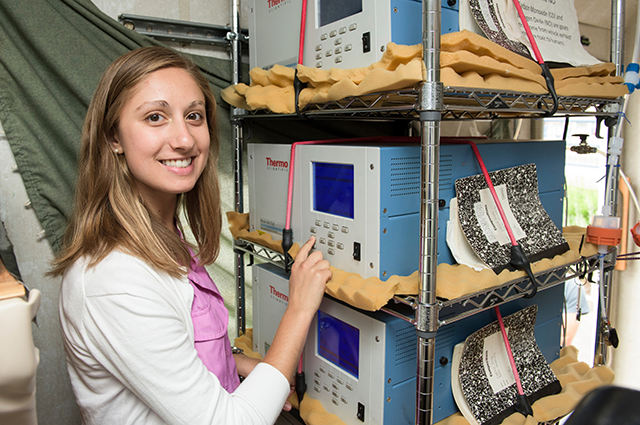Modeling air pollution in Boston

The Summer Scholars program provides rising juniors and seniors with the opportunity to conduct funded independent research projects as undergraduates. The 2016 summer scholars came from across Tufts schools, departments, and disciplines. The nine engineering majors who received funding spent the summer working with their faculty advisors and, during program support events organized by the Office of Undergraduate Education, rubbing shoulders with their peers from the School of Arts and Sciences. From automobile emissions to zwitterions, their summer research projects sought solutions to many of the biggest problems we face today.
By Lynne Powers
Before the Big Dig sank Boston's Interstate 93 beneath the city, the pollution from car exhaust was distributed widely along the length of the highway. Now, it is concentrated in and around the tunnel system. The two questions posed by Jenny Skerker, E17, as part of her summer scholars project are relatively simple, but they have far-ranging implications. How is pollution dispersing as it exits the Central Artery Tunnel, and what are people being exposed to in South Boston, Chinatown, and the North End?
Over the last several years, you might have spotted a Tufts RV driving around Boston. That RV, equipped with fast-response air pollution monitoring equipment and operated by graduate students from the Department of Civil and Environmental Engineering, was collecting data on air quality throughout the city. The data was gathered, but until Skerker and her advisor, Associate Professor John Durant, proposed this project, no one had focused on analyzing air dispersal patterns from the northbound and southbound Central Artery Tunnel exits.
Few, if any, other large American urban areas have a major interstate buried in a tunnel that runs directly beneath the heart of the city. Usually, say Skerker and advisor Durant, tunnels are located in more remote areas; they travel beneath a channel or cut through a mountain pass. Boston presents a unique perfect storm of traffic, high concentrations of exhaust, and people, all in close proximity to each other. With that complexity in mind, Skerker had her work cut out for her.
Her first challenge was to process the data — cut the files down from hours upon hours of readings, to files that ranged from three to 23 minutes in length. She had to be sure to include data from right before the RV entered the tunnel, while it was in the tunnel, and directly after it exited. She also had to account for variables like lag times between when air enters valves to when the machine takes the measurement.
That was only step one. “I have constantly been surprised by how long everything takes!” Skerker says. “I didn't realize that it would take more than half of my summer just to process the data.” As the summer progressed, she began working with AERMOD, the software that she will use to develop a model of air pollution and ultrafine particle dispersal from the tunnel.
Skerker admits there's still a ways to go. Her summer scholars project has wound up becoming the early stages of her senior honor's thesis, which she will work on over the next eight months. Her preliminary findings, however, match her expectations so far. “As you go through the tunnel, the concentrations [of pollution] tend to increase because the movement of cars is […] moving the pollution from the entrance to the exit,” she says. “The measured concentrations then decrease once you exit the tunnel.” She also found that pollution concentrations were highest in the winter, since less air rises in cold temperatures and thus there is less mixing with clean air.
Skerker is looking forward to continuing her work throughout the year, understanding its potential ramifications for public health. She points out that research has demonstrated pollution's negative health effects on the cardiovascular system, the respiratory system, and on cognitive function. Her advisor Durant adds wryly, “Heart, lungs, brain — do you need anything more than that?”
Related Links
Filtering clean drinking water
Defying gravity with an inverted pendulum
Department:
Civil and Environmental Engineering